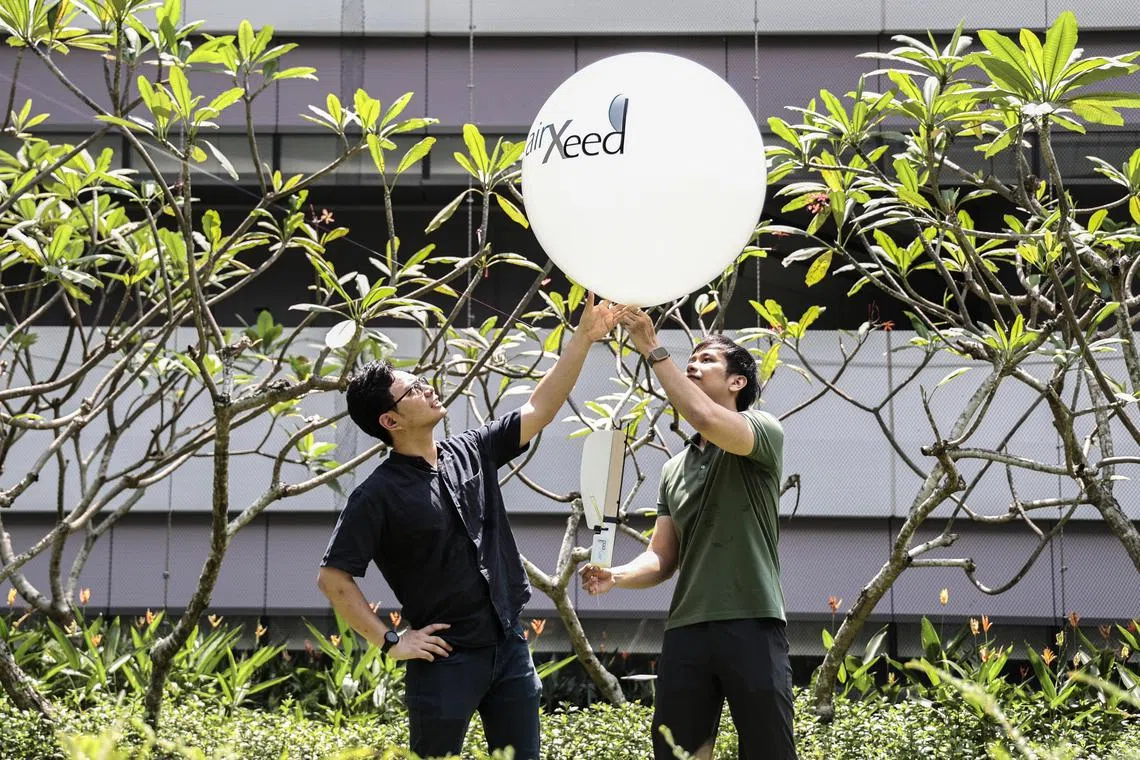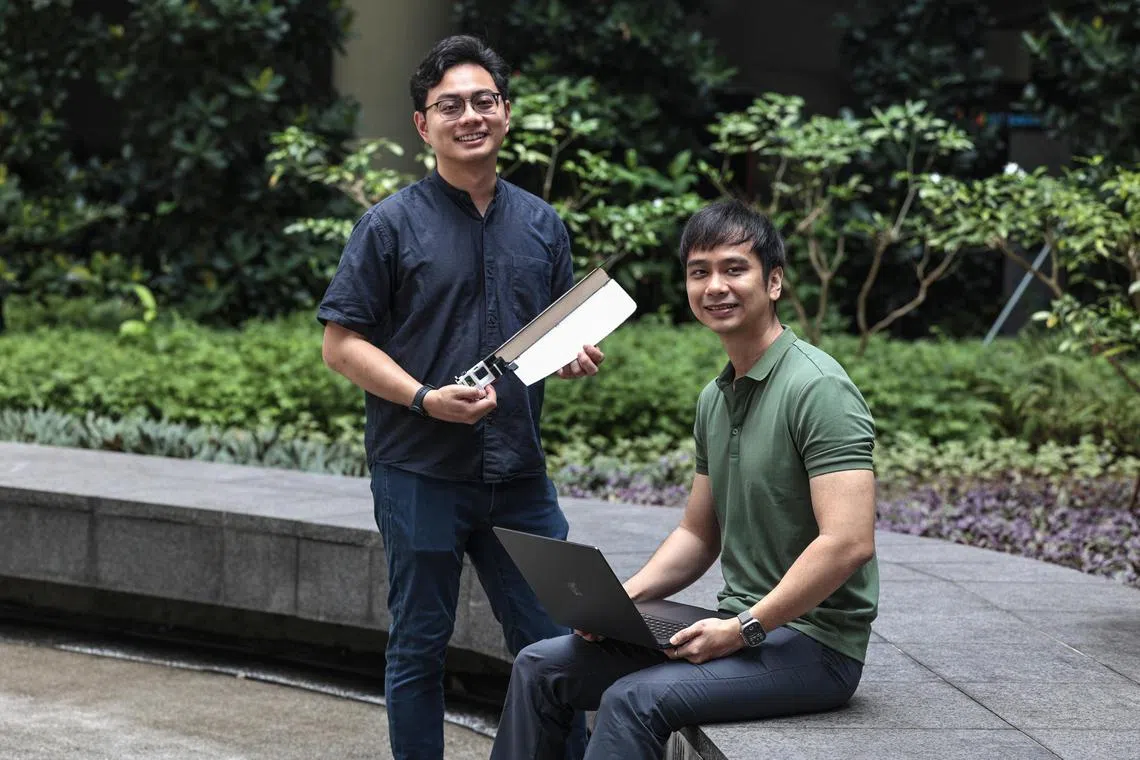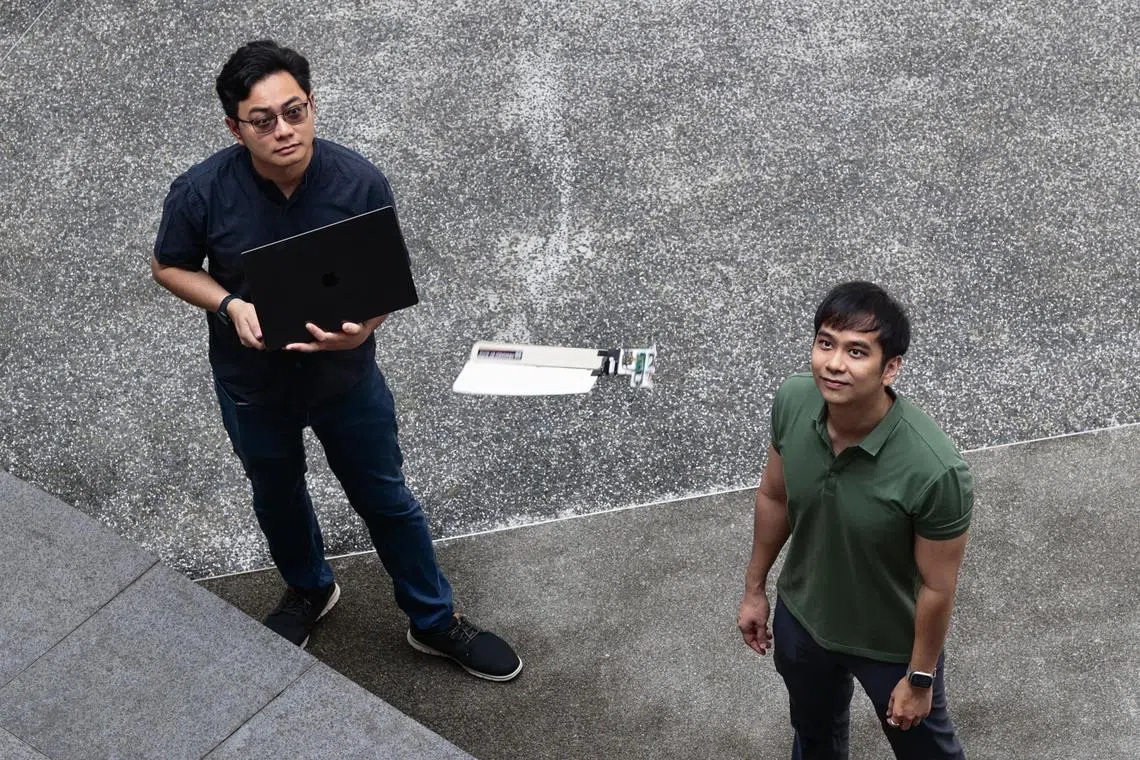Inventors who designed device inspired by maple seed win James Dyson award for sustainability
Sign up now: Get ST's newsletters delivered to your inbox

Post-doctoral research fellows Danial Sufiyan Shaifu (left)l and Shane Kyi Hla Win won the James Dyson Award 2024 for sustainability.
ST PHOTO: HESTER TAN
Follow topic:
SINGAPORE – The fall of a maple seed is slowed down as its wing acts like a parachute, enabling the wind to carry it farther away.
The seed’s asymmetrical shape helps it to remain airborne for longer, spinning like a helicopter’s rotor blades.
Post-doctoral research fellows Shane Kyi Hla Win, 33, and Danial Sufiyan Shaiful, 32, from the Singapore University of Technology and Design (SUTD) were inspired to replicate this movement in a piece of technology that can reduce the electronic waste generated in weather forecasting.
Electronic waste, commonly known as e-waste, refers to any electrical and electronic equipment or device that has been discarded.
The duo beat nearly 2,000 inventions worldwide with their airXeed Radiosonde and clinched the top prize of $50,500, winning on Nov 13 the James Dyson Award 2024 in the sustainability category.
The James Dyson Award is an annual international design award that recognises and supports innovative ideas developed by current and recent design engineering students in the fields of product design, industrial design and engineering.
It was established in 2006 by the James Dyson Foundation, which serves as the company’s charitable trust. The categories typically encompass medical and sustainability themes.
On winning the award, Mr Danial said: “It’s a huge boost in our journey towards turning airXeed Radiosonde into a fully realised solution that can reduce electronic waste and make weather monitoring smarter and more sustainable.”

Post-doctoral research fellows Danial Sufiyan Shaiful (left) and Shane Kyi Hla Win from SUTD set out to make a radiosonde that is more easily retrievable and reusable.
ST PHOTO: HESTER TAN
To collect data for accurate weather forecasts, weather stations worldwide release radiosondes via weather balloons daily. Radiosondes are small devices that measure air pressure, temperature, humidity, wind speed and direction.
However, the weather balloons burst once they reach high altitudes and the radiosondes plummet to the ground, often in remote and inaccessible areas.
Each radiosonde carries about 50g of electronic circuits and lithium batteries.
Almost one million radiosondes are released each year, costing about US$190 million (S$250 million) and causing 48 tonnes of e-waste annually, equivalent to the weight of about 24 cars, said Mr Danial and Mr Kyi.
They set out to make a radiosonde that is more easily retrievable and reusable to reduce e-waste and minimise pollution in remote areas.
The two replicated in their invention the way maple seeds spin as they fall through the air, enabling their radiosonde to spiral during descent and land in an accessible location, making retrieval and reuse easier.

The team designed the radiosonde with modular components for easy repair and recycling of worn or damaged parts.
ST PHOTO: HESTER TAN
The airXeed Radiosonde is programmed to switch automatically between two flight modes – autorotation and diving – to avoid colliding with aeroplanes.
It also has an onboard controller that uses machine learning to stabilise its flight path and land safely near the closest collection zone for reuse.
The team designed the radiosonde with modular components for easy repair and recycling of worn or damaged parts. Sustainable materials like balsa wood and foam were used for the wing and cowling – the radiosonde’s removable cover.
Sir James Dyson, the founder of Dyson, said: “Weather balloons that collect atmospheric information fall back to earth and pollute the environment with electronic waste. Shane and Danial, our sustainability winners, have found a way of returning these devices to earth highly intelligently to where the operators want them to land.
“This is a reusable weather detector, saving environmental waste and saving money. I think it’s a very clever idea.”
The winner of the 2024 James Dyson Award in the medical category is 24-year-old designer Olivia Humphrey from Ireland, who developed a portable device for chemotherapy patients that uses scalp cooling to prevent hair loss.
The winners in the medical and sustainability categories were chosen by Mr Dyson.
On clinching the award for airXeed Radiosonde, Mr Kyi said: “We are going to use this award money to further develop this radiosonde. We want to collaborate with weather stations and radiosonde manufacturers to do more real-world trials and collect more data to perfect our design so that this can be used widely in the world.”
Mr Kyi added that radiosondes sometimes pose a risk if they land in locations such as airports. He mentioned that the Meteorological Service Singapore (MSS) is interested if their solution can prevent radiosondes from landing in areas such as Changi Airport or Paya Lebar Air Base.
Mr Choo Huat Aik, covering director at MSS, said: “We are delighted to see young inventors like Shane and Danial taking an interest in the environmental sustainability of radiosondes with innovations that offer the potential for retrieval and reuse.
“We encourage them to continue innovating with a view to developing practical solutions which can support the meteorological industry.”
Correction note: An earlier version of the story headline wrongly mentioned that the invention was made by SUTD students. It should be by postdoctoral research fellows. This has been corrected.

